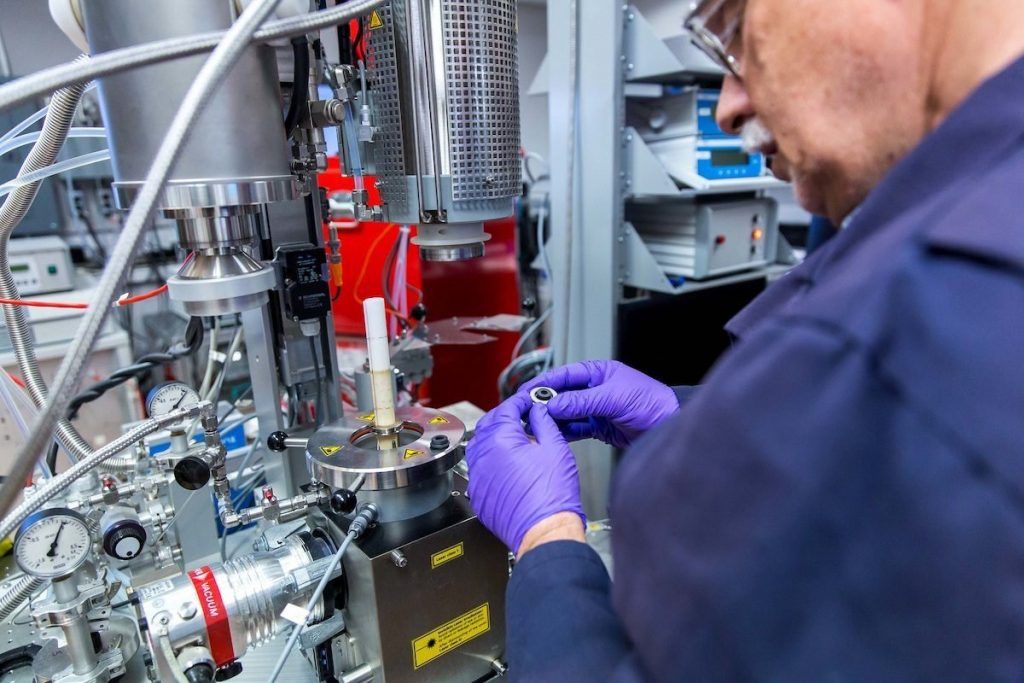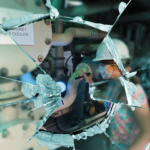Interview: Small modular reactors get a reality check about their waste
By François Diaz-Maurin | June 17, 2022
 Research and development to support the advancement of small modular reactors and advanced reactors. Image courtesy of Canadian Nuclear Laboratories/Flickr (CC BY-ND 2.0)
Research and development to support the advancement of small modular reactors and advanced reactors. Image courtesy of Canadian Nuclear Laboratories/Flickr (CC BY-ND 2.0)
Even before Chernobyl’s RBMK reactor became the standard design of the Soviet Union, it was known to have inherent safety flaws but kept unchanged because it was “cheaper” that way. Historians later found that more than economic and technical considerations, it was social, regulatory, political, and cultural factors that contributed to the RBMK becoming the standard design. More, it was the RBMK’s capacity to embody a vision of the future of the Soviet Union that led to this decision. A few years later, this vision fell apart when the RBMK design suffered from the worst reactor accident the nuclear industry ever had—only to find itself in the middle of a war zone some 36 years later.
Over the past decade, we have witnessed similar hype for small reactors proposed as a potential game-changer for the future of nuclear power. Small modular reactors, or SMRs, are much smaller than the current standard 1000- to 1600-megawatt electric output reactors. Mini-reactors have been heralded as nuclear champions by their promoters, able to meet safety and regulatory requirements, tackle security and nonproliferation concerns, and even embody sociotechnical visions of what a world of abundance powered by SMRs might look like. Such visions have included cheap, risk-free energy that eliminates reactor accidents, an end to energy scarcity, with SMRs powering remote communities and developing economies, a plentiful world where water needs are fulfilled by SMR-powered desalination stations, and an environmentally friendly energy source embedded in a virtuous fuel cycle, with SMRs producing carbon-free and waste-free electricity. Small reactors even have their place in visions of space exploration, assisting future societies in the colonization of the moon, Mars, and possibly other extra-terrestrial worlds.
Scientists have started working on independent reviews of those claims. The results showed that SMRs do not necessarily perform better than gigawatt-scale reactors on a variety of measures. A recent Stanford-led study published in the Proceedings of the National Academy of Sciences (PNAS) provides for the first time a comprehensive analysis of the nuclear waste generated by small modular reactors. The study concludes that most current SMR designs will actually significantly increase the volume and complexity of nuclear waste requiring management and disposal when compared to existing gigawatt-scale light water reactors.
Here, Bulletin associate editor François Diaz-Maurin talks with Lindsay Krall, the lead author of that study and a former MacArthur postdoctoral fellow at Stanford’s Center for International Security and Cooperation (CISAC) who is now based in Sweden.

François Diaz-Maurin: Before we start, most of our readers won’t know what a small reactor is, to begin with. So, let’s help them here. What are small modular reactors, and how do they differ from conventional large-scale reactors?
Lindsay Krall: Sure. A small modular reactor is defined as a reactor with less than 300-megawatt electric output. So “small modular” just refers to the size and the construction strategy, the latter being that the reactors are fabricated as modules in a factory and then shipped on-site by truck where they are assembled. That’s what modular means. Small refers to the energy or the electric output. Sometimes developers call these reactors “plug-and-play.” SMRs can include a huge variety of reactor types depending on the coolant and moderator that they use—from light water to molten salt, sodium, graphite, gas-cooled graphite-moderated reactors, to even lead-cooled reactors.
Diaz-Maurin: In your study, you say that almost half of the SMR designs listed by the IAEA are considered “advanced” reactors that can employ “chemically exotic” fuels and coolants…
Krall: Exactly. Another way in which SMRs differ from current reactors is that, in some of the designs, reactors are passively cooled. That is, instead of having pumps that circulate the coolant, these reactors rely on internal, natural convection around the reactor core. Because they are passively cooled, developers consider these reactors to be “inherently safe.” So, if there is a loss of electricity on-site, the reactor will continue to stay cool through this natural convection flow, because they are not relying on external electricity to run a pump.
Diaz-Maurin: Great. Let’s turn to your research findings now. Most SMRs are said to adopt an “integral” design, in which the reactor core and auxiliary systems are all contained within a reactor vessel. Now, because of their smaller size and compact design, one can expect that SMRs will generate less waste than larger reactors that operate at the gigawatt scale. But you have reached the opposite conclusion in your study, that SMRs will produce more voluminous and chemically/physically reactive waste than light-water reactors. And this by factors of 2 to 30. How is that? It seems counterintuitive…
Krall: Well, one thing that’s clear from the analysis is that the waste output really differs depending on the type of coolant the reactor is using. If it’s using water, then we have processes to treat that water and decontaminate it and hold it so the water coolant itself does not become radioactive waste. However, for a sodium-cooled reactor, for instance, that sodium coolant is likely to become low-level waste at the end of the reactor’s lifetime, because it becomes contaminated and activated during reactor operation. So, the “up to 30 times more waste” that’s been driving the headlines, it’s mostly the sodium coolant. Another aspect is that things in a small reactor do not scale intuitively compared to other forms of energy. For instance, one thing I went into was “neutron leakage.”
Diaz-Maurin: Let’s stay here for a moment. In the paper, you attribute the higher volume of waste generated mainly to “an intrinsically higher neutron leakage associated with SMRs.” Can you explain what neutron leakage means and how it’s driving your results?
Krall: Sure. To put it simply, neutrons are released when there’s a fission reaction. Then, those neutrons are supposed to go forth to propagate the fission chain reaction and help the reactor sustain criticality. But in a small reactor, due to that smaller core size, you’re having more of these neutrons that leak out of the periphery of the fuel. It’s essentially due to the fuel’s surface area to volume ratio, but not exactly. Still, one big issue is that this neutron leakage is then leading to lower fuel burnups. [Fuel burnup – or fuel utilization – is a measure of how much energy is extracted from a given nuclear fuel. The higher the burnup, the more efficient the reactor is.] So that’s what I mean by more physically reactive waste. Say, you start at the same enrichment level, as in a large reactor, the small reactor will have a lower fuel burnup. And due to that lower fuel burnup, you’ll end up with a higher concentration of fissile material in the spent fuel, which can increase the likelihood of recriticality in the spent fuel. [Recriticality is a measure of the potential for fissile materials to spontaneously start a sustained fission reaction.] If a storage or disposal canister fails and becomes flooded with water, recriticality is a bigger risk with the spent fuel from a small reactor and that needs to be mitigated. An effective way to mitigate that risk is to avoid putting a critical mass inside a spent fuel canister.
Diaz-Maurin: Now let’s go back to the wastes themselves. What type of waste are we talking about, anyway? In the paper, you mention spent fuel, high-level waste, and long-lived and short-lived decommissioning waste… Can you walk us through the waste streams from SMRs and how they differ from large reactors?
Krall: Yeah, so SMRs, just like standard commercial reactors, produce spent fuel. And that spent fuel has a particular burnup based on its initial enrichment and how the reactor operated. So, it’s not, you know, like these claims, “oh, we’re going to reduce the mass of spent fuel by 90 percent.” It turns out that a lot of those claims assume that there are several rounds of reprocessing. But based on the license applications of the vendors to the [US Nuclear Regulatory Commission] for these reactors, they’re not. The reprocessing isn’t factored into the reactor design. So, I just use the burnups that are being stated in these reactor applications—when they are stated, because oftentimes, they’re redacted. So just like a large reactor, small modular reactors produce spent fuel. And that spent fuel has a lot of different characteristics that need to be taken into account when you’re storing, transporting, and disposing of it.
Diaz-Maurin: In the paper, you say that compared to large reactors, SMRs will increase the volume and complexity of those wastes. I get the volume part. But what is this complexity about?
Krall: It’s what I mean with “different characteristics” of the spent fuel, not least being this fissile isotope concentration. It also produces heat. It has a particular radionuclide composition, including fission products, which can be both short- and long-lived. And so, I employed four different metrics to measure the spent fuel. And then the long-lived low- and intermediate-level waste in the article is the activated waste. This waste is so close to the reactor core that it absorbs the neutrons that are being leaked and becomes activated. In current reactors, the activated waste is mostly steel from the structural components that keep the core intact. This steel will also become activated in SMRs and, as a result, it will contain short- and long-lived nuclides that need to be dealt with during decommissioning. Reactor decommissioning will require radiation shielding and that steel, the activated steel, will also need to be disposed of in a geologic repository.
Diaz-Maurin: What’s the difference between short-lived and long-lived waste from the perspective of waste management?
Krall: Long-lived waste should be disposed of in a permanent geologic repository—a passively safe, rock cavern with multiple engineered barriers—where the radioactive materials discharged from the reactors will be contained over long periods of time so that they can decay. Short-lived waste includes mostly the reactor structures that have come in contact with a primary coolant that was circulating around the reactor core and through the steam generators. This waste also should go to some sort of disposal site. Sweden, for instance, has a 50-meter-deep repository, whereas some countries just dispose of it in shallow landfills.
Diaz-Maurin: I think I get the complexity too now. And, so, because of that complexity, I see why you need to use several metrics like the chemistry of the spent fuel matrix, its radionuclide content, the heat generated, the radioactive decay, etc. Yet, in the paper, you mention that nuclear technology developers and advocates often employ simple metrics, such as mass, volume, and radioactivity. Indeed, most critics of your study that I’ve seen tend to focus on the waste volume part. Do you think nuclear engineers don’t understand how the chemistry and physics of the spent fuel will affect waste management and disposal?
Krall: I think nuclear waste management is a pretty niche field. It’s a small community of people that think about very bizarre things on a day-to-day basis, like, the 100,000-year evolution of the hydrology at this random location in Sweden. So, I think, there’s definitely a disconnect between the people working on the back end of the fuel cycle—especially with geologic repository development—and those actually designing reactors. And, you know, there is not a lot of motivation for these reactor designers to think about the geologic disposal aspects because the NRC’s new reactor design certification application does not have a chapter on geologic disposal. So…
Diaz-Maurin: That’s interesting, because some developers of SMRs claim they already include a waste disposal program as part of their design program. That would be indeed a much-welcomed development, compared to how conventional reactors have been deployed…
Krall: Well, yes, if they had a chapter on geologic disposal, that would be helpful because at least their proposals could be reviewed in some way or another. I’ve heard reactor designers propose a number of left-field ideas, for instance, “we’re going to dump this sodium reactor in a deep borehole.” People can just shout random thoughts because there’s no accountability for them in proposing an unworkable idea. But if they wrote these proposals down on paper in an NRC application, then at least there might be some way to regulate these unconventional waste management ideas.
Diaz-Maurin: Let’s assume for a moment that license applications of SMRs do include a chapter on waste disposal aspects. Still, things would not be that straightforward. There would still be the problem of the public acceptance of geologic repositories as a possible limiting factor.
Krall: Yes, the public acceptance… I don’t know if that’s anything a reactor designer is going to achieve with geologic repository development. As I said, these nuclear waste management companies are a very niche community. And there are good reasons for that. The most successful geologic disposal programs are those that have best managed to decouple themselves from reactor construction. So, waste management organizations have intentionally separated themselves from the larger nuclear industry as part of their strategy to work towards public acceptance. It would not be beneficial for these organizations to promote reactors and get dragged into the pro- vs. anti-nuclear politics. The best way we can approach it is as: The waste is here, and it needs to be disposed of in a long-term safe way. I don’t think that somebody who is promoting these reactors will achieve public support for a geologic repository.
Diaz-Maurin: Since it was published on May 30, your study generated a lot of responses, including harsh ones, from the nuclear technology developers and advocates. I guess you knew the conclusions of your article would cause some controversy in the nuclear community. But were you surprised at the level of those reactions?
Krall: Yes, there have been a lot of responses—both positive and negative—and I’ve been surprised at everyone’s reaction. You know, for me, coming from the science area where nobody reads the stuff I write—I mean, I can’t even get my supervisors to read it. [Laughter] And then to go to something that’s making headlines… this was a bit shocking for me. And then to see that those headlines focused so heavily on the volume estimates. You know, like, “Small nuclear power projects may have big waste problems”, “Mini nuclear reactors have an outsized waste problem”, and all of that… Obviously, it’s an exciting headline. But that’s not exactly the point I was trying to make in the article. Another issue, I guess, is that I didn’t really know how the article would be released. There was a copy of the paper circulated to the media or to the press some five days in advance of the article’s publication. So, reactor developers were contacted by the press about the article before it was even published. As a scientist, I was just thinking, “Oh, thank God, this paper got accepted, and I don’t have to work with it anymore.” But then the release of the paper shocked me.
Diaz-Maurin: Some critics say you used outdated information in your study. For instance, NuScale’s chief technology officer, Jose Reyes, wrote a letter to the PNAS editor-in-chief where he says your analysis focused on the NuScale 160 megawatt thermal (MWt) core, but that they had already implemented another reactor design, the NuScale 250-MWt core. Reyes then adds that this new design does not produce more spent fuel than existing light water reactors. Does this contradict your findings?
Krall: It doesn’t. It’s actually exactly in line with my findings. We used the certified NuScale reactor, the 160MWt because, with their application to the NRC, there was enough technical data to perform our analysis. It’s interesting to note that their larger 250MWt reactor is going to have to undergo a whole new licensing process. They’re submitting that license application, I think, in December. So, it’s a bit surprising that they’re now marketing a reactor that isn’t licensed. It does seem that this larger reactor will have a higher burnup, of 45 megawatt-days per kilogram, according to NuScale. Well, first of all, that’s still lower than existing full-scale reactors. So, they’re still going to produce more waste, which is a far cry from the general belief that all SMRs will produce less waste. It would be good if they had a higher burnup. But, the higher burnup and consequently lower waste volume, I will guess, is partly driven by the fact that the new design is a larger reactor. So, just as our paper argues, smaller reactors generate more waste.
Diaz-Maurin: So does it mean we should expect future designs of “small” reactors to be up to, say, 999-megawatt electric output?
Krall: Yeah, I think on the larger side of the SMR spectrum, the waste will be more similar to those of existing reactors. So, an important point of the paper is that you need to choose an SMR design carefully, with insight from the back end, so as to avoid disrupting the spent fuel management system too much. In countries with active waste management programs, it’ll be easier to get insight from the back end. But in countries that don’t have such programs, how are people purchasing these reactors going to get insight from the back end? That is not clear to me, especially when it’s not part of the NRC license application.
Diaz-Maurin: In his letter, Reyes also says that you did not contact NuScale for information or clarifications regarding data, such as fuel burnup, that he says they had made publicly available. Is this true?
Krall: We are being accused of not discussing the study with reactor designers. This isn’t true. We did seek information from them, I mean, usable information about their actual design being submitted to the NRC. That information was not given to us. Instead, designers would only speak in generalized terms about an ideal SMR fuel cycle, which is not necessarily what is actually being licensed. And, even this generalized information would be marked as proprietary, not something that I could publish. As scientists, we prefer to reference peer-reviewed analyses. But there is a scarcity of peer-reviewed information in this field.
Diaz-Maurin: The development of SMRs has been around since about the early 2000s. Why are there still only a few studies that analyze the management and disposal of nuclear waste streams from SMRs?
Krall: Well, first, there’s not a lot of funding for it. In my case, for instance, I did most of the research during these fellowship positions where I had funding for it. But I ended the fellowships before the paper was published. So, I spent some time editing the manuscript, submitting it, and revising it all on my own time. And there aren’t a lot of motivating forces to get funding for independent analyses of the waste streams. Since the dominant narrative is that “the waste is manageable and similar to what we currently deal with,” it results in a lack of funding for independent technical reviews of the nuclear fuel cycle. And it’s a real problem.
Diaz-Maurin: As you know, at the Bulletin of the Atomic Scientists, we are committed to reducing manmade threats to our existence. And we are also dedicated to one clear goal of advancing a safe and livable planet. Do you think SMRs could help make our planet a safer place, as their developers tend to suggest?
Krall: I think it depends on the SMR design. For certain SMRs, especially the larger ones, I don’t know where the sweet spot is, but I think they can be viable as long as you choose to construct the right design. But how are you going to choose the right design without any insight from the back end? I think SMRs can be viable if you have insight from the back end when you’re both designing and selecting a design.
Diaz-Maurin: Let me play a little devil’s advocate here. Nuclear waste disposal is becoming reality. Finland just authorized the construction of its deep geological repository for spent nuclear fuel. And other countries are following closely, like France and Sweden, where you work. So why would a little more waste from small modular reactors necessarily be a problem?
Krall: In a country that has a spent fuel management program, whatever design they’re choosing to construct, developers will have insight from the back end, both for decommissioning and for geologic disposal. So I think, SMRs can be deployed safely, as long as the back end is being managed responsibly. But in countries where that’s not the case, I think it’s a bit more like the Wild West.
Together, we make the world safer.
The Bulletin elevates expert voices above the noise. But as an independent nonprofit organization, our operations depend on the support of readers like you. Help us continue to deliver quality journalism that holds leaders accountable. Your support of our work at any level is important. In return, we promise our coverage will be understandable, influential, vigilant, solution-oriented, and fair-minded. Together we can make a difference.















